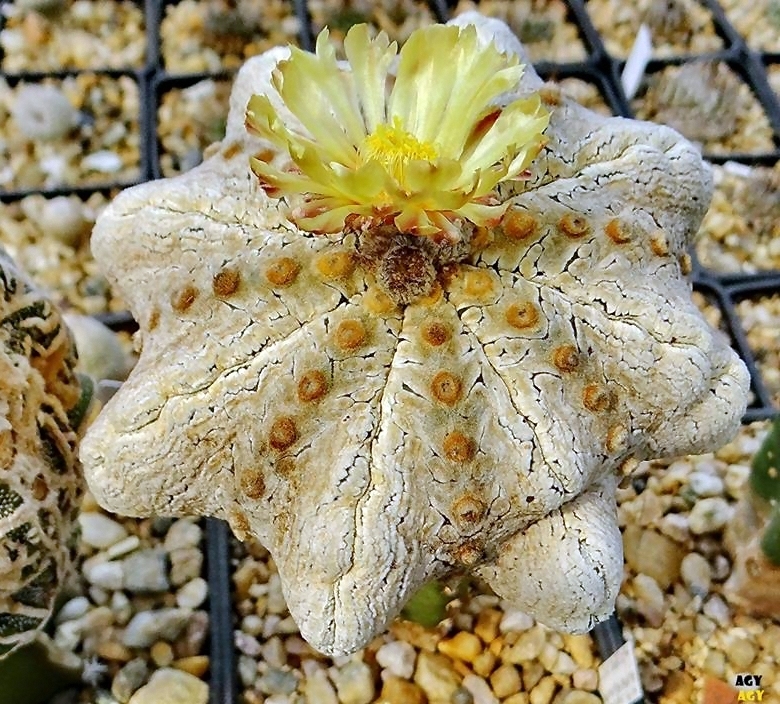
Astrophytum asterias cv. Alpus Photo by: Agócs György
Origin and Habitat: Garden origin (Nursery produced cultivar selected by Japan growers). This Alps super asterias (Alpus Super Kabuto) was created with BA solution (benzyl-adenine solution) by Mr. Sakata, and was named by Mr. Suguri. Although it blooms, seedlings raised from it rarely give rise to other true Alps, it is extremely rare. It has not gained popularity in Japan.
Synonyms:
See all synonyms of Astrophytum asterias
back
Accepted name in llifle Database:Astrophytum asterias (Zucc.) Lem.Cactées 50. 1868Synonymy: 18
Cultivars
(73):
back
Description: Astrophytum asterias cv. AlpusSN|1464]]SN|18011]] is a very nice and distinguishing star shaped and woollier form of Astrophytum asteriasSN|18011]]SN|1464]] cv. Superkabuto. The distinctive characteristic of this cultivars is that the rib-tips (bearing the line of areoles) are more or less deeply seated within the plants body, while the suture line between the ribs is turned outward and more or less expanded. The result is an unique starry-looking white and furry plant. The dilatation of the median lines between areoles varies a lot among specimens and enhances as the plants age, in some cases the suture line expands outward enormously creating odd and unique shapes. When young is quite similar in shape to an ordinary "Super Kabuto".
Stem: Non-branched, flat, dark green. Diameter 8-16 cm star shaped. Height 6 or more centimetres. Just flat to the ground surface.
Ribs: The main particularity of this cultivar are the tip of the rib that are more or less deeply seated within the plants body, while the suture line between the ribs is turned outward.
Ribs: Generally it has eight flat ribs, rare few or more.
Spines: Not any.
Hairy scales: Large dense, white to pale brownish, velvety, almost concealing the epidermis.
Areoles: Round, cream-colored till brownish up to 6 in diameter. The areoles are normally 10 mm apart, but can be very close one to each other in older specimens.
Flowers: At the apex from the vegetation point, up to 75 mm in diameter. Yellow with red throat.
Subspecies, varieties, forms and cultivars of plants belonging to the Astrophytum asterias group
 Astrophytum asterias (Zucc.) Lem.: Non-branched, flat, dark green. Just flat to the ground surface, the plant body grows on the native habitat practically complete buried . Only in cultivation plants may have a spherical till columnar shape. Diameter 3-8(-16) cm. Height 2 to 6 cm.
Astrophytum asterias (Zucc.) Lem.: Non-branched, flat, dark green. Just flat to the ground surface, the plant body grows on the native habitat practically complete buried . Only in cultivation plants may have a spherical till columnar shape. Diameter 3-8(-16) cm. Height 2 to 6 cm. Astrophytum asterias f. aurea hort.: Mutant completely lacking chlorophyll pigment. The result is a completely yellow or yellow-orange plant.
Astrophytum asterias f. aurea hort.: Mutant completely lacking chlorophyll pigment. The result is a completely yellow or yellow-orange plant. Astrophytum asterias f. cristatum hort.: The crested form only deviate from the typical form for the stem which is fan shaped up to 30 cm (or more ) in diameter with age.
Astrophytum asterias f. cristatum hort.: The crested form only deviate from the typical form for the stem which is fan shaped up to 30 cm (or more ) in diameter with age. Astrophytum asterias var. nudum Y.Itô: (a.k.a. cv. Ruri Kabuto) This form has a very characteristic glabrous stem lacking the white tufts of loose hairy scales typical of the common Astrophytum asterias.
Astrophytum asterias var. nudum Y.Itô: (a.k.a. cv. Ruri Kabuto) This form has a very characteristic glabrous stem lacking the white tufts of loose hairy scales typical of the common Astrophytum asterias. Astrophytum asterias var. nudum f. aurea hort.: Nude mutant completely lacking chlorophyll pigment. The result is a completely yellow plant.
Astrophytum asterias var. nudum f. aurea hort.: Nude mutant completely lacking chlorophyll pigment. The result is a completely yellow plant. Astrophytum asterias var. nudum f. cristata hort.: Crested nude form.
Astrophytum asterias var. nudum f. cristata hort.: Crested nude form. Astrophytum asterias var. nudum f. rubra hort.: has nude ribs of a bright orange-red colour due to the absence (or reduced production) of chlorophyll pigments.
Astrophytum asterias var. nudum f. rubra hort.: has nude ribs of a bright orange-red colour due to the absence (or reduced production) of chlorophyll pigments. Astrophytum asterias f. proliferum hort.: This form varies from the typical Astrophytum asterias for the tendency to branch forming small side pups from the areole.
Astrophytum asterias f. proliferum hort.: This form varies from the typical Astrophytum asterias for the tendency to branch forming small side pups from the areole. Astrophytum asterias var. roseiflorum Frič: Selected form with pink coloured flowers. However a very few pink flowered specimens will appear time by time among normal yellow flowered plants.
Astrophytum asterias var. roseiflorum Frič: Selected form with pink coloured flowers. However a very few pink flowered specimens will appear time by time among normal yellow flowered plants. Astrophytum asterias cv. Akabana: (Akabana Kabuto) Its flowers are red, which is very uncharacteristic of this genus. Petals are shaded in dark pinkish-red, orange-red or purple wine-red with usually even darker flower edges.
Astrophytum asterias cv. Akabana: (Akabana Kabuto) Its flowers are red, which is very uncharacteristic of this genus. Petals are shaded in dark pinkish-red, orange-red or purple wine-red with usually even darker flower edges. Astrophytum asterias cv. Alpus: the of rib tips (bearing the line of areoles) are more or less deeply seated within the plants body, while the suture line between the ribs is turned outward and more or less expanded creating odd and unique shapes.
Astrophytum asterias cv. Alpus: the of rib tips (bearing the line of areoles) are more or less deeply seated within the plants body, while the suture line between the ribs is turned outward and more or less expanded creating odd and unique shapes.- Astrophytum asterias cv. Ekubo Kabuto
 Astrophytum asterias cv. Elephant Skin: has a bumpy elephant-like skin.
Astrophytum asterias cv. Elephant Skin: has a bumpy elephant-like skin.  Astrophytum asterias cv. Feather Flower: has colourful fringed petals.
Astrophytum asterias cv. Feather Flower: has colourful fringed petals.  Astrophytum asterias cv. Fukuryiu: Plant with dditional ribs. This plant will develop protuberances (like beginnings of ribs) or small extra ribs (more or less prominent ). Usually these additional ribs will not reach the plant apex.
Astrophytum asterias cv. Fukuryiu: Plant with dditional ribs. This plant will develop protuberances (like beginnings of ribs) or small extra ribs (more or less prominent ). Usually these additional ribs will not reach the plant apex.- Astrophytum asterias cv. Gelbe Bluete
 Astrophytum asterias cv. Godzilla: Has reptile-like skin.
Astrophytum asterias cv. Godzilla: Has reptile-like skin. Astrophytum asterias cv. Gokuu-kabuto
Astrophytum asterias cv. Gokuu-kabuto- Astrophytum asterias cv. Golden kabuto
 Astrophytum asterias cv. Goryo Kabuto (Five Ribs): 5 ribbed form available with different pattern of the spots.
Astrophytum asterias cv. Goryo Kabuto (Five Ribs): 5 ribbed form available with different pattern of the spots. Astrophytum asterias cv. Goryo Kabuto (Five Ribs) + Ruri: has nude stems with only 5 ribs.
Astrophytum asterias cv. Goryo Kabuto (Five Ribs) + Ruri: has nude stems with only 5 ribs. Astrophytum asterias cv. Goryo Kabuto (Five Ribs) + Ruri + Fukuryiu + Ooibo
Astrophytum asterias cv. Goryo Kabuto (Five Ribs) + Ruri + Fukuryiu + Ooibo Astrophytum asterias cv. Hakuun: This cultivar varies from the typical A. asterias for the white flecks that condense, forming characteristic cloud-like patches.
Astrophytum asterias cv. Hakuun: This cultivar varies from the typical A. asterias for the white flecks that condense, forming characteristic cloud-like patches.- Astrophytum asterias cv. Hakuun forma prolifera: Plant distingushed for the white flecks that condense, forming characteristic cloud-like patches and for the tendency to branch forming small side pups from the areole.
- Astrophytum asterias cv. Hanaizumi
 Astrophytum asterias cv. Hanazono: Some additional woolly areoles are produced on the ribs surface. Flowers buds develop from the median line between two ribs and usually they are not produced by areoles.
Astrophytum asterias cv. Hanazono: Some additional woolly areoles are produced on the ribs surface. Flowers buds develop from the median line between two ribs and usually they are not produced by areoles. Astrophytum asterias cv. Hanazono Star Type
Astrophytum asterias cv. Hanazono Star Type- Astrophytum asterias cv. Ibosaki Kabuto
 Astrophytum asterias cv. Ikaryoko: Monstrous form.
Astrophytum asterias cv. Ikaryoko: Monstrous form.- Astrophytum asterias cv. Kigan Kabuto
 Astrophytum asterias cv. Kikko: (Kikko Kabuto) It has raised tubercles along the ribs edges, in fact its areoles stick out with large notches between them, giving them a bumpy look.
Astrophytum asterias cv. Kikko: (Kikko Kabuto) It has raised tubercles along the ribs edges, in fact its areoles stick out with large notches between them, giving them a bumpy look. Astrophytum asterias cv. Kikko Lizard Skin: has broad raised tubercles with a lizard Skin and the plant appears decorated with a geometrical design which is raised above the surface, giving it a bumpy look.
Astrophytum asterias cv. Kikko Lizard Skin: has broad raised tubercles with a lizard Skin and the plant appears decorated with a geometrical design which is raised above the surface, giving it a bumpy look.  Astrophytum asterias cv. Kikko Nudum: This is the nude form of "Kikko" with raised tubercles along the ribs edges, it resembles some chinned cacti particularly some Gymocalyciums.
Astrophytum asterias cv. Kikko Nudum: This is the nude form of "Kikko" with raised tubercles along the ribs edges, it resembles some chinned cacti particularly some Gymocalyciums. Astrophytum asterias cv. Kikko Nudum f. aurea: This is the albinos form of "Kikko" (Mutant completely lacking chlorophyll pigment) The result is a completely cream-white, yellow or reddish plant.
Astrophytum asterias cv. Kikko Nudum f. aurea: This is the albinos form of "Kikko" (Mutant completely lacking chlorophyll pigment) The result is a completely cream-white, yellow or reddish plant. Astrophytum asterias cv. Kikko Nudum f. cristata: crested form.
Astrophytum asterias cv. Kikko Nudum f. cristata: crested form. Astrophytum asterias cv. Kikko Nudum violet: This is the violet schizochromic form form of "Kikko". The result is a magenta-violet plant.
Astrophytum asterias cv. Kikko Nudum violet: This is the violet schizochromic form form of "Kikko". The result is a magenta-violet plant.- Astrophytum asterias cv. Kiku Kabuto
- Astrophytum asterias cv. Kofuki Kabuto
- Astrophytum asterias cv. Koo-yo
 Astrophytum asterias cv. Mamma Kikko: has ribs completely divides in tubercles that resemble women breasts. When viewed from above the plants resemble a tortoise-shell.
Astrophytum asterias cv. Mamma Kikko: has ribs completely divides in tubercles that resemble women breasts. When viewed from above the plants resemble a tortoise-shell.- Astrophytum asterias cv. Mirakuru Kabuto
- Astrophytum asterias cv. Mottles
 Astrophytum asterias cv. muscle: has green ribs with large creamy white areoles and for the abnormal tendency to branch forming small side pups. Ribs usually 8 with raised tubercles giving them a bumpy look.
Astrophytum asterias cv. muscle: has green ribs with large creamy white areoles and for the abnormal tendency to branch forming small side pups. Ribs usually 8 with raised tubercles giving them a bumpy look. Astrophytum asterias cv. muscle cristatum: crested form with green ribs with large creamy white areoles.
Astrophytum asterias cv. muscle cristatum: crested form with green ribs with large creamy white areoles.- Astrophytum asterias cv. Musha Kabuto
 Astrophytum asterias cv. Nisiki (orange): has sectors, patches or stripes with distinct shades of orange-red.
Astrophytum asterias cv. Nisiki (orange): has sectors, patches or stripes with distinct shades of orange-red. Astrophytum asterias cv. Nisiki (yellow): has sectors, patches or stripes with distinct shades of yellow.
Astrophytum asterias cv. Nisiki (yellow): has sectors, patches or stripes with distinct shades of yellow.- Astrophytum asterias cv. Nohakuten Kabuto: Heavily flecked form.
- Astrophytum asterias cv. Ohkan Kabuto
 Astrophytum asterias cv. Ooibo + Ruri (nudum) Kabuto: Plant with large woolly areoles (typical of cv. Ooibo) and with green nude stem ( Typical of cv. Rury Kabuto)
Astrophytum asterias cv. Ooibo + Ruri (nudum) Kabuto: Plant with large woolly areoles (typical of cv. Ooibo) and with green nude stem ( Typical of cv. Rury Kabuto) Astrophytum asterias cv. Ooibo Kabuto: Japanese selected strain with big wooly areoles, the colour of the wool also varies from pure white, to pastel, yellowish, orangish or brownish depending on the clone.
Astrophytum asterias cv. Ooibo Kabuto: Japanese selected strain with big wooly areoles, the colour of the wool also varies from pure white, to pastel, yellowish, orangish or brownish depending on the clone.- Astrophytum asterias cv. Rasen Kabuto
 Astrophytum asterias cv. Rensei: It is a nice selection with densely packaged areoles (usually orangish) on the rib edges. The areoles tend to merge, forming an almost continuous line.
Astrophytum asterias cv. Rensei: It is a nice selection with densely packaged areoles (usually orangish) on the rib edges. The areoles tend to merge, forming an almost continuous line. Astrophytum asterias cv. Ruri Kabuto Akabana: has smooth green stem of cv. Ruri Kabuto (Astrophytum asterias var. nudum) and bright red flowers of cv. Akabana.
Astrophytum asterias cv. Ruri Kabuto Akabana: has smooth green stem of cv. Ruri Kabuto (Astrophytum asterias var. nudum) and bright red flowers of cv. Akabana. Astrophytum asterias cv. Ruri Kabuto Nisiki (Orange-Red): a.k.a.: forma nuda variegata (Orange-Red Type)
Astrophytum asterias cv. Ruri Kabuto Nisiki (Orange-Red): a.k.a.: forma nuda variegata (Orange-Red Type) Astrophytum asterias cv. Ruri Kabuto Nisiki (Yellow): a.k.a.: forma nuda variegata (Yellow Type)
Astrophytum asterias cv. Ruri Kabuto Nisiki (Yellow): a.k.a.: forma nuda variegata (Yellow Type)- Astrophytum asterias cv. Sakata Kabuto
 Astrophytum asterias cv. Showa: (a.k.a. Shinshowa Kabuto) has yellow flowers with very fine petals, cut into shreds.
Astrophytum asterias cv. Showa: (a.k.a. Shinshowa Kabuto) has yellow flowers with very fine petals, cut into shreds. Astrophytum asterias cv. Showa Red: (a.k.a. Red Shinshowa Kabuto) has pink-red or orange-red flowers with very fine petals, cut into shreds.
Astrophytum asterias cv. Showa Red: (a.k.a. Red Shinshowa Kabuto) has pink-red or orange-red flowers with very fine petals, cut into shreds.  Astrophytum asterias cv. Star Type: This cultivar only varies from the typical A. asterias for the star shaped stem instead of rounded .
Astrophytum asterias cv. Star Type: This cultivar only varies from the typical A. asterias for the star shaped stem instead of rounded . Astrophytum asterias cv. Super Hanazono: has the inimitable furry additional areoles of cv. Hanazono with the large mosaic of extensive white spots of cv. Superkabuto. The result is an intensely white and furry plant.
Astrophytum asterias cv. Super Hanazono: has the inimitable furry additional areoles of cv. Hanazono with the large mosaic of extensive white spots of cv. Superkabuto. The result is an intensely white and furry plant. Astrophytum asterias cv. Superkabuto: Distinguished from the normal A. asterias by the epidermis, that does not have simple dots, but a mosaic of extensive white spots that make the plant look intensely maculate.
Astrophytum asterias cv. Superkabuto: Distinguished from the normal A. asterias by the epidermis, that does not have simple dots, but a mosaic of extensive white spots that make the plant look intensely maculate. Astrophytum asterias cv. Superkabuto + Ooibo: has very large characteristic and woolly areoles, the colour of the wool also varies from pure white, to pastel, yellowish, orangish or brownish depending on the clone.
Astrophytum asterias cv. Superkabuto + Ooibo: has very large characteristic and woolly areoles, the colour of the wool also varies from pure white, to pastel, yellowish, orangish or brownish depending on the clone.  Astrophytum asterias cv. Superkabuto + Rensei (Line Areoles): has densely packaged areoles (often orangish) on the rib edges. The areoles tend to merge, forming an almost continuous line.
Astrophytum asterias cv. Superkabuto + Rensei (Line Areoles): has densely packaged areoles (often orangish) on the rib edges. The areoles tend to merge, forming an almost continuous line.  Astrophytum asterias cv. Superkabuto f. cristata: The crested form of "SUPERKABUTO", only deviate from the typical form for the stem which is fan shaped up to 30 cm (or more ) in diameter with age.
Astrophytum asterias cv. Superkabuto f. cristata: The crested form of "SUPERKABUTO", only deviate from the typical form for the stem which is fan shaped up to 30 cm (or more ) in diameter with age. Astrophytum asterias cv. Superkabuto f. monstruosa: has slender, triangular ariocarpus-like tubercles around the woolly crown of a spherical flattened stem covered by a creamy-white felt.
Astrophytum asterias cv. Superkabuto f. monstruosa: has slender, triangular ariocarpus-like tubercles around the woolly crown of a spherical flattened stem covered by a creamy-white felt. Astrophytum asterias cv. Superkabuto f. prolifera: distinguishable for the tendency to branch forming small side pups from the areole..
Astrophytum asterias cv. Superkabuto f. prolifera: distinguishable for the tendency to branch forming small side pups from the areole.. Astrophytum asterias cv. Superkabuto f. prolifera cristata: this is a peculiar crested form with an abnormal tendency to branch forming small side pups from the areole.
Astrophytum asterias cv. Superkabuto f. prolifera cristata: this is a peculiar crested form with an abnormal tendency to branch forming small side pups from the areole.  Astrophytum asterias cv. Superkabuto Five Ribs: The form with only five ribs, is particularly rare because many of the 5 ribbed seedlings that occasionally appear will usually develop additional ribs in a few years as they age.
Astrophytum asterias cv. Superkabuto Five Ribs: The form with only five ribs, is particularly rare because many of the 5 ribbed seedlings that occasionally appear will usually develop additional ribs in a few years as they age. Astrophytum asterias cv. Superkabuto Snow Type: It differ for the dense white covering of dots that almost conceal the epidermis, this particular form is also called "Snow White", or “White Form” .
Astrophytum asterias cv. Superkabuto Snow Type: It differ for the dense white covering of dots that almost conceal the epidermis, this particular form is also called "Snow White", or “White Form” . Astrophytum asterias cv. Superkabuto Snow Type f. cristata: crested form with stems completely concealed by tufts of bright white hairy scales.
Astrophytum asterias cv. Superkabuto Snow Type f. cristata: crested form with stems completely concealed by tufts of bright white hairy scales. Astrophytum asterias cv. Superkabuto Snow Type f. monstruosa: produces odd bumped shapes with branches completely concealed by tufts of bright white hairy scales, and it is possible to find clones with different degrees of monstrosity.
Astrophytum asterias cv. Superkabuto Snow Type f. monstruosa: produces odd bumped shapes with branches completely concealed by tufts of bright white hairy scales, and it is possible to find clones with different degrees of monstrosity. Astrophytum asterias cv. Superkabuto Star Type: Typical "Superkabuto" with extensive white spots, but with star shaped stem instead of rounded. .
Astrophytum asterias cv. Superkabuto Star Type: Typical "Superkabuto" with extensive white spots, but with star shaped stem instead of rounded. . Astrophytum asterias cv. Superkabuto Star Type + Snow type
Astrophytum asterias cv. Superkabuto Star Type + Snow type Astrophytum asterias cv. Superkabuto Star Type + V Type: This is a very nice and distinguishing plant that combine the star shaped form with the V pattern of the "V type" form.
Astrophytum asterias cv. Superkabuto Star Type + V Type: This is a very nice and distinguishing plant that combine the star shaped form with the V pattern of the "V type" form. Astrophytum asterias cv. Superkabuto Sutadorimu: (Star Dream)
Astrophytum asterias cv. Superkabuto Sutadorimu: (Star Dream) Astrophytum asterias cv. Superkabuto V type: a.k.a. "V-type", “Fly's wings type” or “Tiger”. It differs for the diverse pattern that form distinct v-shaped lines resembling the shape of fly's wings.
Astrophytum asterias cv. Superkabuto V type: a.k.a. "V-type", “Fly's wings type” or “Tiger”. It differs for the diverse pattern that form distinct v-shaped lines resembling the shape of fly's wings. Astrophytum asterias cv. Superkabuto V type f. cristatum
Astrophytum asterias cv. Superkabuto V type f. cristatum Astrophytum asterias cv. Superkabuto Yellow Dots Type
Astrophytum asterias cv. Superkabuto Yellow Dots Type- Astrophytum asterias cv. Taryo Kabuto
 Astrophytum asterias cv. Thirteen ribs: The normal rib number (eight) is very stable in wild specimens. The form with thirteen ribs is quite exceptional.
Astrophytum asterias cv. Thirteen ribs: The normal rib number (eight) is very stable in wild specimens. The form with thirteen ribs is quite exceptional. - Astrophytum asterias cv. Wakareryu
 Astrophytum asterias cv. Alpus Photo by: Prof. Ilham Alakbarov
Astrophytum asterias cv. Alpus Photo by: Prof. Ilham Alakbarov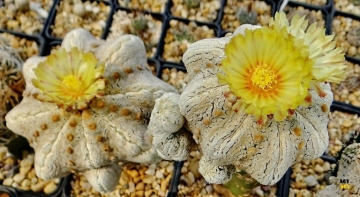 Astrophytum asterias cv. Alpus Photo by: Agócs György
Astrophytum asterias cv. Alpus Photo by: Agócs György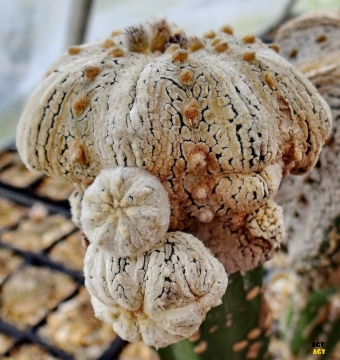 Astrophytum asterias cv. Alpus Photo by: Agócs György
Astrophytum asterias cv. Alpus Photo by: Agócs György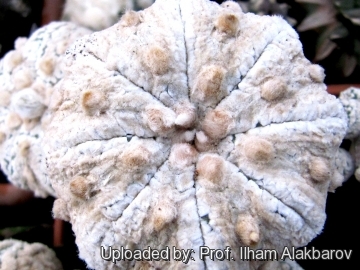 Astrophytum asterias cv. Alpus Photo by: Prof. Ilham Alakbarov
Astrophytum asterias cv. Alpus Photo by: Prof. Ilham Alakbarov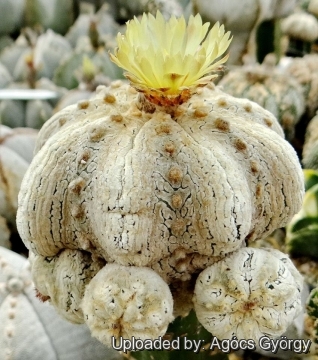 Astrophytum asterias cv. Alpus Photo by: Agócs György
Astrophytum asterias cv. Alpus Photo by: Agócs György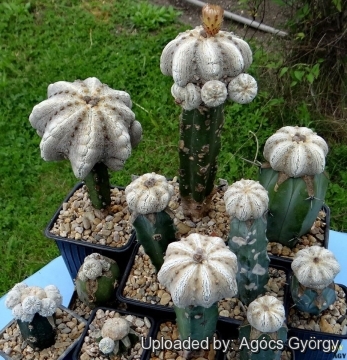 Astrophytum asterias cv. Alpus Photo by: Agócs György
Astrophytum asterias cv. Alpus Photo by: Agócs GyörgyCultivation and Propagation: Astrophytum asterias cv. AlpusSN|18011]]SN|18011]] are relatively easy plants thought slow to grow. They are usually seen as a grafted plants but grow well on their own roots too and make great potted specimens, but very slowgrowing.
Soil: They grow well in a rich, well drained soil such us pumice, lava grit, and only a little peat or leaf-mould.
Repotting: If potted, repot them preferably in the spring, if their roots become cramped. Generally, they should be repotted every other year in order to provide fresh soil. However, this doesn't necessarily mean they'll need larger containers. Fill about a quarter of the pot with broken crocks, gravel, etc. to promote good drainage. After repotting, do not water for a week or more. Use pot with good drainage. Eventually, as the plant becomes mature grow it slowly, and adopt a new repotting period, using intervals of every 2 - 3 years. Additionally grow it under drier conditions or with stronger sunlight.
Watering: Water sparingly from March until October so long as the plant pot is allowed to drain and not sit in a tray of water (It rots easily, especially if over wet), and also needs to be avoided wetting the body of this plant while it is in sunlight. A wet cactus in the sun light can cause sun burning which can lead to scares or even fungal infections and death.. Let dry between watering. During hot weather you may need to water the plants more frequently so long as the plant is actively growing. From late September watering should be reduced to force the plant to go in to a state of semi dormancy, by October you should be back in to the winter watering regime. If the soil is allowed to be dry for too long root loss could follow but equally the same result would occur if the plants are both wet and cold. From March onward the plant will begin to grow and watering should be increased gradually until late May when the plant should be in full growth
Fertilization: Feed with a high potassium fertilizer in summer. Feeding may not be necessary at all if the compost is fresh then, feed in summer only if the plant hasn't been repotted recently. Do not feed the plants from September onward as this can cause lush growth which can be fatal during the darker cold months.
Hardiness: When dormant, the plant is slightly cold tolerant (down to nearly -5° C or less), but when left out it is more sensitive to frost. However warmth throughout the year will increase the grower's success (at minimum temperatures from 5 to 15 centigrade degrees during rest season). During the summer it is best to keep the plants outside where the temperature can rise to over 30 C with no harm to the plant. In the rest period no high atmospheric humidity!!
Exposure: They do need a lot of light to develop their typical compact shape, but different clones vary in their tolerance of full sunshine. However some protection in light shade is recommended during the hottest hours in summer. They can tolerate moderate shade, and a plant that has been growing in shade should be slowly hardened off before placing it in full sun as the plant will be severely scorched if moved too suddenly from shade into sun. If kept too dark they may become overly lush and greener and could be prone to rotting due to over watering.
Uses: They are excellent plants for container growing. It always looks good and stays small.
Diseases and pests: Watch for infestations of mealybugs, scale insects and spider mite. Rot is only a minor problem with cacti if the plants are watered and “aired” correctly. If they are not, fungicides won't help all that much.
Propagation: Almost exclusively by seed. Plants are sometimes grafted onto column-shaped cacti. Seed Collecting: Permit fruit to ripen. Fruit must be significantly overripe before harvesting seed; clean and dry seeds.

















